Nano-grating Assisted Light Absorption Enhancement for MSM-PDs Performance Improvement: An Updated Review
Abstract
1. Introduction
2. Basic Structures of MSM-PDs and Nano-Grating Structures
3. Working Mechanism and Performance Parameters of MSM-PDs
3.1. Theoretical Aspects
3.2. Basic Working Mechanisms and Key Performance Parameters of MSM-PDs
4. Advance States of Simulated Results and Discussion
5. Conclusions
Author Contributions
Funding
Conflicts of Interest
References
- Liu, M.Y.; Chou, S.Y. Nanoscale metal-semiconductor-metal photodetectors with sub-picosecond response time fabricated using electron beam lithography. J. Vac. Sci. Technol. B 1992, 10, 2932–2935. [Google Scholar] [CrossRef]
- Huang, Z. Multi Gigahertz Indium Gallium Arsenide/Indium Phosphide Inverted MSM Photodetectors for Photoreceiver and Waveguide Applications. Ph.D. Thesis, Georgia Institute of Technology, Atlanta, GA, USA, 15 November 2003. [Google Scholar]
- Das, N. Nanostructured Photodetector for Enhanced Light Absorption. Computational Nanotechnology Using Finite Difference Time Domain; CRC Press: Boca Raton, FL, USA, 2013; pp. 251–290. [Google Scholar]
- Dahal, R. Fabrication and Characterization of III-Nitride Nanophotonic Devices. Ph.D. Thesis, Kansas State University, Manhattan, KS, USA, 2009. [Google Scholar]
- Smith, F.W.; Le, H.Q.; Diadiuk, V.; Hollis, M.A.; Calawa, A.R.; Gupta, S.; Frankel, M.; Dykaar, D.R.; Mourou, G.A.; Hsiang, T.Y. Picosecond GaAs-based photoconductive optoelectronic detectors. Appl. Phys. Lett. 1989, 54, 890–892. [Google Scholar] [CrossRef]
- Darweesh, A.A. Optical Enhancement in Periodic Plasmonic Gratings for SERS and Metal-Semiconductor-Metal Photodetectors (MSM-PDs) Applications. Ph.D. Thesis, University of Arkansas, Fayetteville, AR, USA, 2019; p. 3182. [Google Scholar]
- Hetterich, J.; Bastin, G.; Gippius, N.A.; Tikhodeev, S.G.; von Plessen, G.; Lemmer, U. Optimized design of plasmonic MSM photodetector. IEEE J. Quantum. Electron. 2007, 43, 855–859. [Google Scholar] [CrossRef]
- Cinel, N.A. EBL Fabricated Plasmonic Nanostructures for Sensing Applications. Ph.D. Thesis, Bilkent University, Ankara, Turkey, 2013. [Google Scholar]
- Shen, L. Ultrafast Photodetector on the InP-Membrane-on-Silicon Platform. Ph.D. Thesis, Technische Universiteit Eindhoven, Eindhoven, The Netherlands, 10 November 2016. [Google Scholar]
- BenMoussa, A.; Hochedez, J.F.; Dahal, R.; Li, J.; Lin, J.Y.; Jiang, H.X.; Soltani, A.; DeJaeger, J.-C.; Kroth, U.; Richter, M. Characterization of AIN metal-semiconductor-metal diodes in the spectral range of 44–360 nm: Photoemmission assessments. Appl. Phys. Lett. 2008, 92, 022108. [Google Scholar] [CrossRef]
- Hasan, R.M. Metal Oxide, Group V–VI Chalcogenides and GAN/ALGAN Photodetectors. Ph.D. Thesis, George Mason University, Fairfax, VA, USA, 2016. [Google Scholar]
- Sze, S.M.; Li, Y.; Ng, K.K. Physics of Semiconductor Devices, 3rd ed.John Wiley & Sons, Inc.: Hobboken, NJ, USA, 2007. [Google Scholar]
- Nasir, A.; Jung-Wook, M.; Chun Hong, K.; Abdullah, A.; Davide, P.; Ram Chandra, S.; Malleswararao, T.; Tien Khee, N.; Boon, S.O. Deep-ultraviolet integrated photonic and optoelectronic devices: A prospect of the hybridization of group III– nitrides, III–oxides, and two-dimensional materials. J. Semiconductors 2019, 40, 121801. [Google Scholar] [CrossRef]
- Dahal, R.; Li, J.; Fan, Z.Y.; Nakarmi, M.L.; Al Tahtamouni, T.M.; Lin, J.Y.; Jiang, H.X. AlN MSM and Schottky photodetectors. Physica Status Solidi C 2008, 5, 2148–2151. [Google Scholar] [CrossRef]
- Cai, Y.; Shen, S.; Zhu, C.; Zhao, X.; Bai, J.; Wang, T. Nonpolar (11) GaN metal–semiconductor–metal photodetectors with superior performance on silicon. ACS Appl. Mater. Interfaces 2020, 12, 25031–25036. [Google Scholar] [CrossRef] [PubMed]
- Shi, L.; Chen, K.; Zhai, A.; Li, G.; Fan, M.; Hao, Y.; Zhu, F.; Zhang, H.; Cui, Y. Status and Outlook of Metal–Inorganic Semiconductor–Metal Photodetectors. Laser Photonics Rev. 2020, 15, 2000401. [Google Scholar] [CrossRef]
- Casalino, M.; Iodice, M.; Sirleto, L.; Rao, S.; Rendina, I.; Coppola, G. Low dark current silicon-on-insulator waveguide metal-semiconductor-metal-photodetector based on internal photoemissions at 1550 nm. J. Appl. Phys. 2013, 114, 153103. [Google Scholar] [CrossRef]
- Sugeta, T.; Urisu, T. WP-B2 high-gain metal—Semiconductor—Metal photodetectors for high-speed optoelectronic circuits. IEEE Trans. Electron Devices 1979, 26, 1855–1856. [Google Scholar] [CrossRef]
- Figueroa, L.; Slayman, C. A novel heterostructure interdigital photodetector (HIP) with picosecond optical response. IEEE Electron Device Lett. 1981, 2, 208–210. [Google Scholar] [CrossRef]
- Wei, C.; Klein, H.-J.; Beneking, H. Symmetrical Mott barrier as a fast photodetector. Electron. Lett. 1981, 17, 688–690. [Google Scholar] [CrossRef]
- Slayman, C.; Figueroa, L. Frequency and pulse response of a novel high-speed interdigital surface photoconductor (IDPC). IEEE Electron Device Lett. 1981, 2, 112–114. [Google Scholar] [CrossRef]
- Ghosh, S.; Lin, K.-C.; Tsai, C.-H.; Kumar, H.; Chen, Q.; Zhang, L.; Son, B.; Tan, C.S.; Kim, M.; Mukhopadhyay, B.; et al. Metal-Semiconductor-Metal GeSn Photodetectors on Silicon for Short-Wave Infrared Applications. Micromachines 2020, 11, 795. [Google Scholar] [CrossRef] [PubMed]
- Kashyap, R.; Nemova, G. Surface Plasmon Resonance-Based Fiber and Planar Waveguide Sensors. J. Sens. 2009, 2009, 1–9. [Google Scholar] [CrossRef]
- Sano, E. A device model for metal-semiconductor-metal photodetectors and its applications to optoelectronic integrated circuit simulation. IEEE Trans. Electron Devices 1990, 37, 1964–1968. [Google Scholar] [CrossRef]
- Burm, J.; Litvin, K.I.; Schaff, W.J.; Eastman, L.F. Optimization of high-speed metalsemiconductor-metal photodetectors. IEEE Photonics Technol. Lett. 1994, 6, 722–724. [Google Scholar] [CrossRef]
- Nusir, A.I.; Hill, A.M.; Manasreh, M.O.; Herzog, J.B. Near-infrared metalsemiconductor-metal photodetector based on semi-insulating GaAs and interdigital electrodes. Photonics Res. 2015, 3, 1–4. [Google Scholar] [CrossRef]
- Das, N.; Karar, A.; Vasiliev, M.; Tan, C.L.; Alameh, K.; Lee, Y.T. Analysis of nano-grating-assisted light absorption enhancement in metal-semiconductor-metal photodetectors patterned using focused ion-beam lithography. Opt. Commns. 2011, 284, 1694–1700. [Google Scholar] [CrossRef]
- Karar, A.; Das, N.; Tan, C.L.; Alameh, K.; Lee, Y.T.; Karouta, F. High-responsivity plasmonics-based GaAs metal-semiconductor-metal photo-detectors. Appl. Phys. Lett. 2011, 99, 133112. [Google Scholar] [CrossRef]
- Tan, C.L.; Lysak, V.V.; Das, N.; Karar, A.; Alameh, K.; Lee, Y.T. Absorption enhancement of MSM photo-detector structure with a plasmonic double grating structure. In Proceeding of the 2010 10th IEEE Conference on Nanotechnology (IEEE-NANO 2010), Seoul, Korea, 17–20 August 2010. [Google Scholar]
- Soole, J.B.D.; Schumacher, H. InGaAs metal-semiconductor-metal photodetectors for long wavelength optical communication. IEEE J. Quantum Electron. 1991, 27, 737–752. [Google Scholar] [CrossRef]
- Guo, J.; Tu, Y.; Yang, L.; Wang, L.; Wang, B. Design of a double grating-coupled surface plasmon color filter. In Proceedings of the Optical Components and Materials XIII, San Francisco, CA, USA, 15–17 February 2016; SPIE: Bellingham, WA, USA, 2016; Volume 9744, p. 97440C. [Google Scholar]
- Xiong, X.H.; Zhan, L.M.; Ke, X. Effects of grating slant angle on surface plasmon resonance and its applications for sensors. Appl. Mech. Mater. 2014, 536, 342–345. [Google Scholar] [CrossRef]
- Masouleh, F.F.; Das, N.; Mashayekhi, H.R. Comparison of different plasmonic nano-grating profiles for quality light absorption in nanostructured metal-semiconductor-metal photodetectors. Opt. Eng. 2013, 12, 45–46. [Google Scholar]
- Das, N.; Masouleh, F.F.; Mashayekhi, H.M. Light absorption and reflection in nanostructured GaAs metal–semiconductor–metal photo-detectors. IEEE Trans. Nanotech. 2014, 13, 982–989. [Google Scholar] [CrossRef]
- Masouleh, F.F.; Das, N.; Mashayekhi, H.R. Assessment of amplifying effects of ridges spacing and height on nano-structured MSM photo-detectors. Opt. Quantum Electron. 2015, 47, 193–201. [Google Scholar] [CrossRef]
- Le, K.Q.; Ngo, Q.M.; Nguyen, T.K. Nanostructured metal-insulator-metal metamaterials for refractive index biosensing applications: Design, fabrication, and characterization. IEEE J. Sel. Top Quantum Electron. 2016, 23, 388–393. [Google Scholar] [CrossRef]
- Masouleh, F.F.; Das, N.; Mashayekhi, H.R. Optimization of light transmission efficiency for nano-grating assisted MSM-PDs by varying physical parameters. Phot. Nano Fund. Appl. 2014, 12, 45–53. [Google Scholar] [CrossRef]
- Das, N.; Karar, A.; Tan, C.L.; Alameh, K.; Lee, Y.T. Impact of Nanograting Phase-Shift on Light Absorption Enhancement in Plasmonics-Based Metal-Semiconductor-Metal Photodetectors. Adv. Opt. Technol. 2011, 2011, 1–8. [Google Scholar] [CrossRef]
- Fan, Z.; Su, Y.; Zhang, H.; Han, X.; Ren, F. Analysis of aluminum nano-gratings assisted light reflection reduction in GaAs metal-semiconductor-metal photodetectors. In Proceedings of the SPIE Optics + Photonics for Sustainable Energy, San Diego, CA, USA, 9–13 August 2015; The International Society for Optics and Photonics (SPIE): Bellingham, WA, USA, 2015; p. 95630T. [Google Scholar]
- Darweesh, A.A.; Bauman, S.J.; Herzog, J.B. Improved optical enhancement using double-width plasmonic gratings with nanogaps. Photonics Res. 2016, 4, 173–180. [Google Scholar] [CrossRef]
- Masouleh, F.F.; Das, N.; Rozati, S.M. Optimal subwavelength design for efficient light trapping in central slit of plasmonics-based metal-semiconductor-metal photo-detectors. Opt. Quant. Electron. 2015, 47, 1477–1485. [Google Scholar] [CrossRef]
- Chandan, N.; Das, N.; Masouleh, F.F. Analysis of plasmonics-based nano-structured MSM-PDs for enhanced light absorption. In Proceeding of the 2017 Eleventh International Conference on Sensing Technology (ICST), Sydney, NSW, Australia, 4–6 December 2017; pp. 1–5. [Google Scholar]
- Masouleh, F.F.; Rozati, S.M.; Das, N. Performance improvement of plasmonic-based thin film assisted MSM-PDs. Optik 2018, 157, 733–742. [Google Scholar] [CrossRef]
- Massenot, S.; Chevallier, R.; Parriaux, O. Tunable grating-assisted surface plasmon resonance by use of nano-polymer dispersed liquid crystal electro-optical material. Optics Commun. 2007, 275, 318–323. [Google Scholar] [CrossRef][Green Version]
- García-Martín, A.; Ward, D.R.; Natelson, D.; Cuevas, J.C. Field enhancement in subnanometer metallic gaps. Phys. Rev. B 2011, 83, 193404. [Google Scholar] [CrossRef]
- Kashyap, S.; Kaur, H. Enhancement of Light Absorption in Plasmonic Based Photodetector with Double Nanograting Structure. Available online: https://assets.researchsquare.com/files/rs-505093/v1/0d1d274f-78b6-406c-b7fa-30be5ebf4a6f.pdf?c=1631882990 (accessed on 27 November 2021).
- Ding, M.; Guo, Z.; Chen, X.; Ma, X.; Zhou, L. Surface/Interface Engineering for Constructing Advanced Nanostructured Photodetectors with Improved Performance: A Brief Review. Nanomaterials 2020, 10, 362. [Google Scholar] [CrossRef]
- Savoia, S.; Ricciardi, A.; Crescitelli, A.; Granata, C.; Esposito, E.; Galdi, V.; Cusano, A. Surface sensitivity of Rayleigh anomalies in metallic nanogratings. Opt. Express 2013, 21, 23531–23542. [Google Scholar] [CrossRef] [PubMed]
- Darweesh, A.A.; Bauman, S.J.; Brawley, Z.T.; Herzog, J.B. Improved optical enhancement in binary plasmonic gratings with nanogap spacing. In Proceedings of the Nanoengineering: Fabrication, Properties, Optics, and Devices XIII, San Diego, CA, USA, 30–31 August 2016; p. 99270Z. [Google Scholar]
- Abdulhalim, I.; Zourob, M.; Lakhtakia, A. Surface plasmon resonance for biosensing: A mini-review. Electromagnetics 2008, 28, 214–242. [Google Scholar] [CrossRef]
- Khan, F.; Khan, W.; Kim, S.-D. High-Performance Ultraviolet Light Detection Using Nano-Scale-Fin Isolation AlGaN/GaN Heterostructures with ZnO Nanorods. Nanomaterials 2019, 9, 440. [Google Scholar] [CrossRef] [PubMed]
- Khan, W.; Ajmal, H.; Khan, F.; Huda, N.; Kim, S.-D. Induced photonic response of ZnO Nanorods Grown on oxygen plasma-treated seed crystallites. Nanomaterials 2018, 8, 371. [Google Scholar] [CrossRef] [PubMed]
- Alenezi, M.R.; Henley, S.J.; Silva, S.R.P. On-chip fabrication of high performance nanostructured ZnO UV detectors. Sci. Rep. 2015, 5, 8516. [Google Scholar] [CrossRef] [PubMed]
- Oener, S.Z.; van de Groep, J.; Macco, B.; Bronsveld, P.C.P.; Kessels, W.M.M.; Polman, A.; Garnett, E.C. Metal–Insulator–Semiconductor Nanowire Network Solar Cells. Nano Lett. 2016, 16, 3689–3695. [Google Scholar] [CrossRef]
- Fadakar Masouleh, F.; Das, N.; Rozati, S.M. Nano-Structured Gratings for Improved Light Absorption Efficiency in Solar Cells. Energies 2016, 9, 756. [Google Scholar] [CrossRef]
- Shalev, E.; Oksenberg, E.; Rechav, K.; Popovitz-Biro, R.; Joselevich, E. Guided CdSe Nanowires Parallelly Integrated into Fast Visible-Range Photodetectors. ACS Nano 2017, 11, 213–220. [Google Scholar] [CrossRef] [PubMed]
- Lee, M.; Son, H.; Lee, H.-Y.; e Moon, J.; Kim, H.; Park, J.-I.; Liu, Z.; Hahm, M.G.; Yang, M.; Kim, U.J. Nanovoid-driven high crystalline aluminum nitride and its application in solar blind UV photodetectors. J. Mater. Chem. C 2020, 8, 14431–14438. [Google Scholar] [CrossRef]
- Wei, T.-C.; Tsai, D.-S.; Ravadgar, P.; Ke, J.-J.; Tsai, M.-L.; Lien, D.-H.; Huang, C.-Y.; Horng, R.-H.; He, J.-H. See-through Ga2O3 solar-blind photodetectors for use in harsh environments. IEEE J. Sel. Topics Quantum Electron. 2014, 20, 3802006. [Google Scholar]
- Iqbal, T.; Tehseen, A.; Bashir, A.; Afsheen, S.; Tahir, M.B.; Abrar, M. Study of plasmonic bandgap of optimization of geometrical parameters of metallic grating devices. Solid State Commun. 2021, 327, 114212. [Google Scholar] [CrossRef]
- Ding, Y.; Yoon, J.; Javed, M.H.; Song, S.H.; Magnusson, R. Mapping Surface-Plasmon Polaritons and Cavity Modes in Extraordinary Optical Transmission. IEEE Photonics J. 2011, 3, 365–374. [Google Scholar] [CrossRef]
- Al-Azzawi, A. Photonics: Principles and Practices; CRC Press: Boca Raton, FL, USA, 2006. [Google Scholar]
- Wang, S.Y.; Bloom, D.M. 100 GHz bandwidth planar GaAs Schottky photodiode. Electron. Lett. 1983, 19, 554. [Google Scholar] [CrossRef]
- Roth, W.; Schumaher, H.; Kluge, J.; Geelen, H.J.; Beneking, H. The DSI diode—A fast large-area optoelectronic detector. IEEE Trans. Electron Devices 1985, 32, 1034. [Google Scholar] [CrossRef]
- Chen, X.; Wang, D.; Wang, T.; Yang, Z.; Zou, X.; Wang, P.; Luo, W.; Li, Q.; Liao, L.; Hu, W.; et al. Enhanced photoresponsivity of a GaAs nanowire metal-semiconductor-metal photodetector by adjusting the fermi level. ACS Appl. Mater. Interfaces 2019, 11, 33188. [Google Scholar] [CrossRef] [PubMed]
- Kalinina, E.V.; Lebedev, A.A.; Kozlovski, V.V.; Zabrodskiy, V.V.; Strelchuk, A.M.; Nikitina, I.P. Electrophysical and Optical Properties of 4H-SiC UV Detectors Irradiated with Electrons. Mater. Sci. Forum 2019, 963, 722. [Google Scholar] [CrossRef]
- Walker, D.; Monroy, E.; Kung, P.; Wu, J.; Hamilton, M.; Sanchez, F.J.; Diaz, J.; Razeghi, M. High-speed, low-noise metal–semiconductor–metal ultraviolet photodetectors based on GaN. Appl. Phys. Lett. 1999, 74, 762. [Google Scholar] [CrossRef]
- Afzal, N.; Devarajan, M.; Ibrahim, K. Growth of AlInN film on GaAs substrate and its application to MSM UV photodetector. Mater. Res. Express 2016, 3, 085904. [Google Scholar] [CrossRef]
- Ahmed, A.A.; Hashim, M.R.; Abdalrheem, R.; Rashid, M. High-performance multicolor metal-semiconductor-metal Si photodetector enhanced by nanostructured NiO thin film. J. Alloys Compd. 2019, 798, 300. [Google Scholar] [CrossRef]
- Shi, L.; Cui, Y.; Gao, Y.; Wang, W.; Zhang, Y.; Zhu, F.; Hao, Y. High performance ultrathin MoO3/Ag transparent electrode and its application in semitransparent organic solar cells. Nanomaterials 2018, 8, 473. [Google Scholar]
- Chen, M.W.; Chen, C.Y.; Lien, D.H.; Ding, Y.; He, J.H. Photoconductive enhancement of single ZnO nanowire through localized Schottky effects. Opt. Express 2010, 18, 14836. [Google Scholar]
- Li, X.; Chen, X.; Xu, X.; Hu, X.; Zuo, Z. Enhanced Performance of a Visible Light Detector Made with Quasi-Free-Standing Graphene on SiC. Materials 2019, 12, 3227. [Google Scholar]
- Das, N.; Karar, A.; Tan, C.L.; Vasiliev, M.; Alameh, K.; Lee, Y.T. Metal-semiconductor-metal (MSM) photodetectors with plasmonic nanogratings. Pure Appl. Chem. 2011, 83, 2107–2113. [Google Scholar] [CrossRef]
- Opti-FDTD. OptiFDTD Technical Background and Tutorials, 12th ed.; Optiwave: Ottawa, ON, Canada, 2014. [Google Scholar]
- Hasan, I.M. FDTD Analysis of Plasmonic and Nanojet Enhanced Photodetectors for Improved Performance. Master’s Thesis, The University of New Mexico, Albuquerque, NM, USA, 2012. [Google Scholar]
- Bütün, S.; Cinel, N.A.; Özbay, E. Nano-antenna coupled UV subwavelength photodetectors based on GaN. Opt. Exp. 2012, 20, 2649–2656. [Google Scholar] [CrossRef]
- Maslihan, A.Z. Modelling and Analysis of Nano-Structured Metal-Semiconductor-Metal Photo-Detectors for Enhanced Light Absorption. Bachelor’s Thesis, Curtin University, Perth, WA, Australia, 2014. [Google Scholar]
- Islam, A.; Uzzal, M.; Das, N.; Hasan, M. Modeling and Analysis of Different Nano-gratings to Enhance Light Absorption in MSM-PDs. In Proceedings of the 2019 International Conference on Robotics, Electrical and Signal Processing Techniques (ICREST), Dhaka, Bangladesh, 10–12 January 2019; pp. 369–373. [Google Scholar]
- Islam, A.; Das, N.; Uzzal, M.M. A Comprehensive Study on the Impact of Various Nano-gratings on MSM-PDs for Enhancement in the Light Absorption. AIUB J. Sci. Eng. 2019, 18, 27–34. [Google Scholar] [CrossRef]
- Basher, M.K.; Vasiliev, M.; Das, N. Physical Vapor-Deposited Silver (Ag)-Based Metal-Dielectric Nanocomposites for Thin-Film and Coating Applications. Appl. Sci. 2021, 11, 6746. [Google Scholar] [CrossRef]
- Chang, W.R.; Fang, Y.K.; Ting, S.F.; Tsair, T.S.; Chang, C.N.; Lin, C.Y.; Chen, S.F. The hetero-epitaxial SiCN/Si MSM photodetector for high-temperature deep-UV detecting applications. IEEE Electron. Device Lett. 2003, 24, 565–567. [Google Scholar] [CrossRef]
- Juang, F.R.; Fang, Y.K.; Chiang, Y.T.; Chou, T.H.; Cheng, I.L. A high-performance n-i-p SiCN homojunction for low-cost and high-temperature ultraviolet detecting applications. IEEE Sens. J. 2011, 11, 150–154. [Google Scholar] [CrossRef]
- Sang, L.; Liao, M.; Sumiya, M. A Comprehensive Review of Semiconductor Ultraviolet Photodetectors: From Thin Film to One-Dimensional Nanostructures. Sensors 2013, 13, 10482–10518. [Google Scholar] [CrossRef] [PubMed]
- Amorim, M.; Savio, R.; Massi, M.; Santiago, H. Applications of SiC-Based Thin Films in Electronic and MEMS Devices. In Physics and Technology of Silicon Carbide Devices; InTech: London, UK, 2012. [Google Scholar]
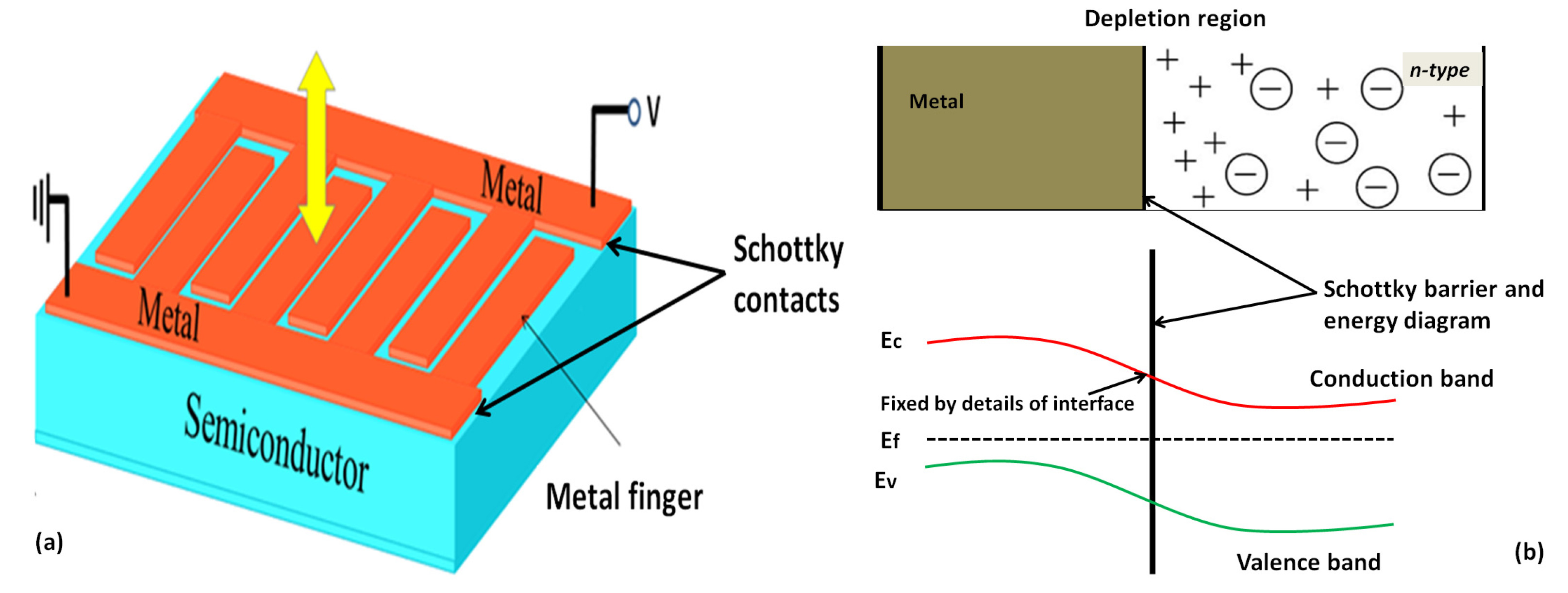



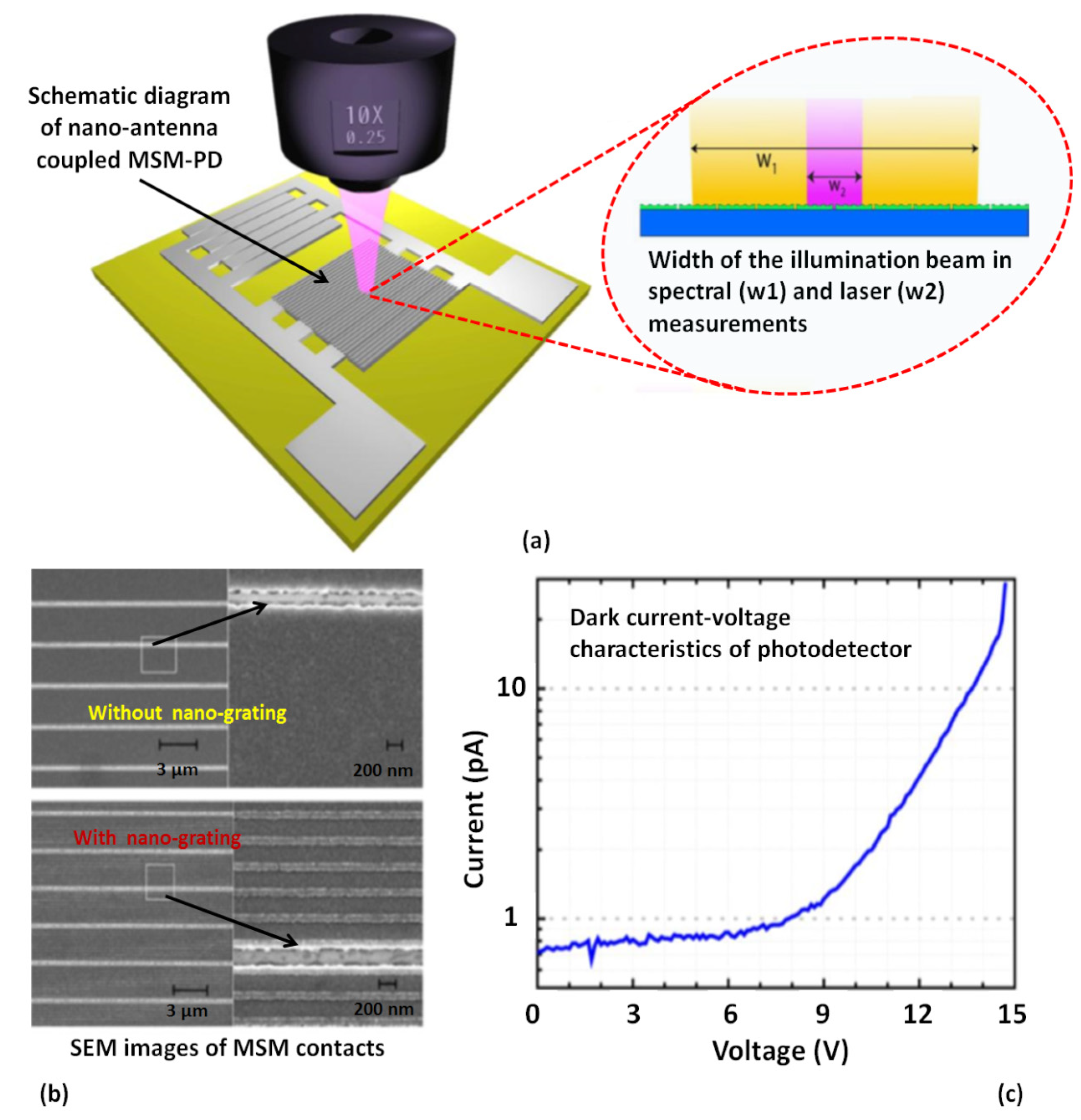
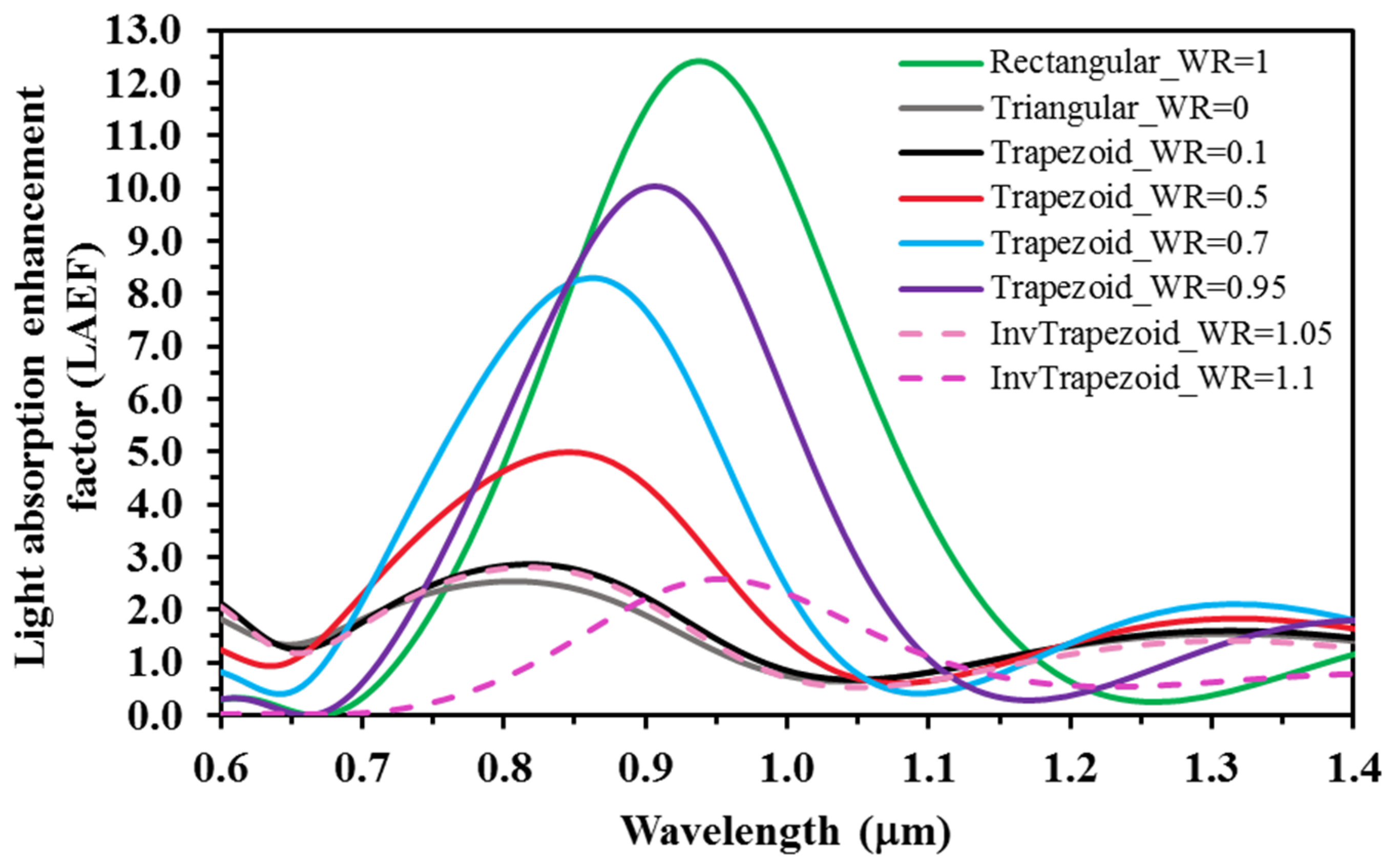
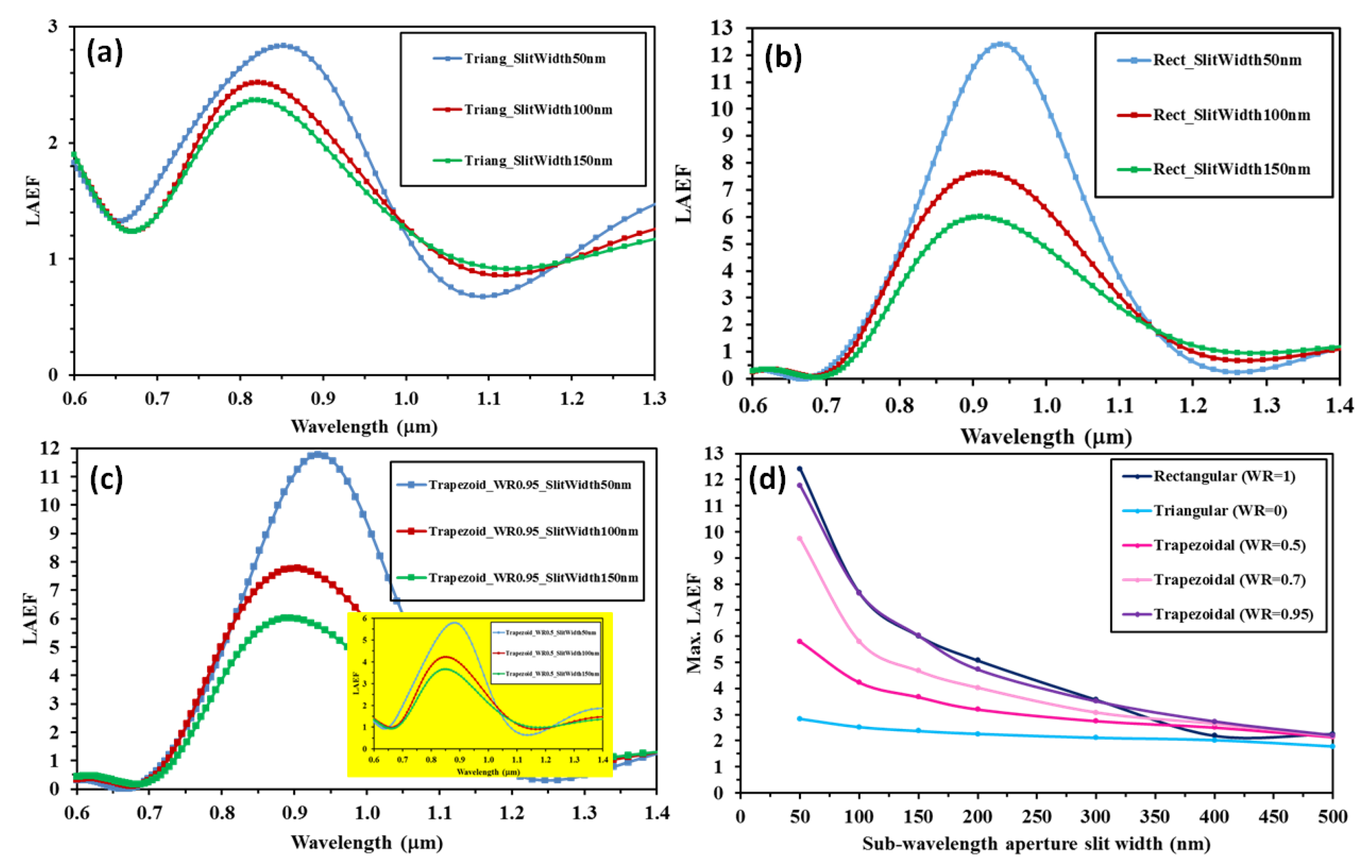
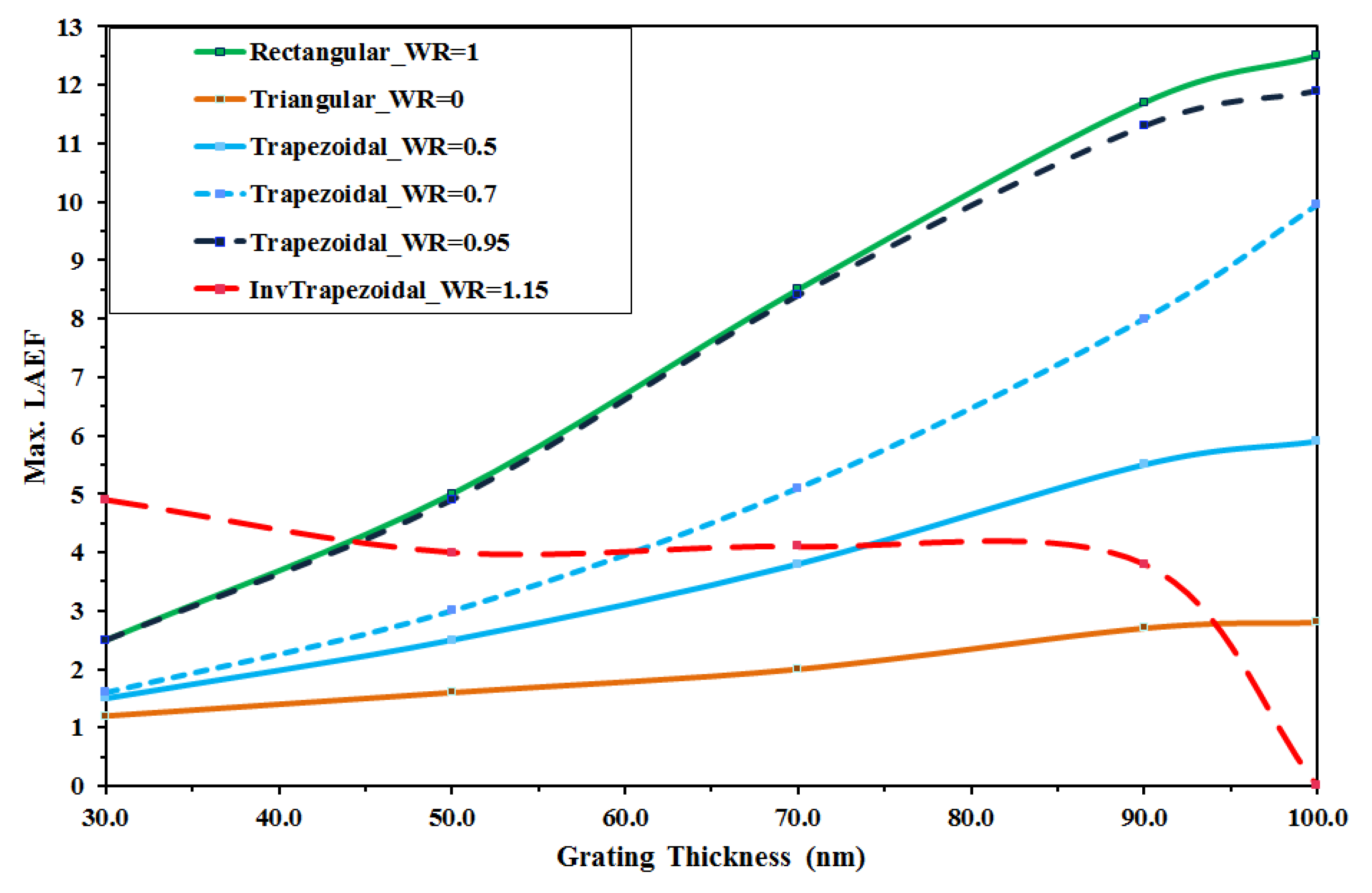

Publisher’s Note: MDPI stays neutral with regard to jurisdictional claims in published maps and institutional affiliations. |
© 2021 by the authors. Licensee MDPI, Basel, Switzerland. This article is an open access article distributed under the terms and conditions of the Creative Commons Attribution (CC BY) license (https://creativecommons.org/licenses/by/4.0/).
Share and Cite
Das, N.; Nur-E-Alam, M.; Islam, A.; Ain, A.Z.M. Nano-grating Assisted Light Absorption Enhancement for MSM-PDs Performance Improvement: An Updated Review. Photonics 2021, 8, 539. https://doi.org/10.3390/photonics8120539
Das N, Nur-E-Alam M, Islam A, Ain AZM. Nano-grating Assisted Light Absorption Enhancement for MSM-PDs Performance Improvement: An Updated Review. Photonics. 2021; 8(12):539. https://doi.org/10.3390/photonics8120539
Chicago/Turabian StyleDas, Narottam, Mohammad Nur-E-Alam, Alif Islam, and Ain Zulaikha Maslihan Ain. 2021. "Nano-grating Assisted Light Absorption Enhancement for MSM-PDs Performance Improvement: An Updated Review" Photonics 8, no. 12: 539. https://doi.org/10.3390/photonics8120539
APA StyleDas, N., Nur-E-Alam, M., Islam, A., & Ain, A. Z. M. (2021). Nano-grating Assisted Light Absorption Enhancement for MSM-PDs Performance Improvement: An Updated Review. Photonics, 8(12), 539. https://doi.org/10.3390/photonics8120539







